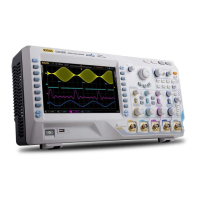RIGOL Chapter 3 Horizontal System Setting
3-6 DS4000E User’s Guide
According to
or
(wherein, θ is the phase deviation angle between the
channels; the definitions of
,
,
and
are as shown in the figure above),
you can calculate the phase deviation angle.
or
If the principal axis of the ellipse is within quadrant I and III, the phase deviation
angle obtained should be within quadrant I and IV, namely within (0 to π/2) or (3π/2
to 2π). If the principal axis of the ellipse is within quadrant II and IV, the phase
deviation angle obtained should be within quadrant II and III, namely within (π/2 to
π) or (π to 3π/2).
Application example: measure the phase deviation of the input
signals of two channels.
Method 1: Use Lissajous method
1. Connect a sine signal to CH1 and then connect a sine signal with the same
frequency and amplitude but a 90° phase deviation to CH2.
2. Press AUTO and turn on the X-Y time base mode.
If the XY1 area display is turned on, please move to the next step. If the XY1
area display is turned off, press XY1 to switch to “On”.
3. Use VERTICAL POSITION of CH1 and CH2 to display the signals at the
center of the screen and use VERTICAL
SCALE of CH1 and CH2 to make
the signals easy to observe (if necessary, please refer to “
To Adjust the
Vertical Scale” to switch the vertical scale adjustment mode). At this point, the
circle as shown in the figure below should be displayed.

